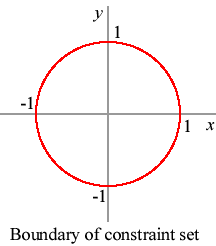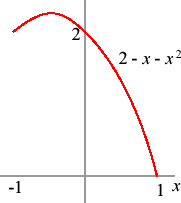5.1 Exercises on necessary conditions for an interior optimum
- Find all the global maximizers and minimizers of the following functions of a single variable.
- f(x) = 1 − x on the interval [0, 1].
- f(x) = (x − 1/3)2 on the interval [0, 1].
- f(x) = x3 − 2x2 + x on the interval [0, 2].
In all three cases, the function f is continuous and the constraint set is compact, so the extreme value theorem implies that the problem has a solution.- We have f'(x) = −1, so the function has no stationary points. Thus the only candidates for maximizers and minimizers are the endpoints of the interval, 0 and 1. We have f(0) = 1 and f(1) = 0, so the global maximizer is x = 0, yielding a value for the function of 1, and the global minimizer is x = 1, yielding the value 0.
- We have f'(x) = 2(x − 1/3), so that the function has a single stationary point, x = 1/3, at which the value of the function is 0. We have also f(0) = 1/9 and f(1) = 4/9, so the global maximizer is x = 1 and the global minimizer is 1/3; the global maximum is f(1) = 4/9 and the global minimum is f(1/3) = 0.
- We have f'(x) = 3x2 − 4x + 1, so f'(x) = 0 if and only if (3x − 1)(x − 1) = 0, or if and only if x = 1/3 or x = 1. The values of f at these two points are f(1/3) = 4/27 and f(1) = 0. The values of f at the endpoints of its domain are f(0) = 0 and f(2) = 2. Thus the global maximizer is 2 (with a value of 2) and the global minimizers are 0 and 1 (with a value of 0).
- Let a and b be numbers, with 0 < a < b < 1. Define the function f by f(x) = bx − ax for x ∈ [0, ∞). Find the values of x that maximize and minimize
f(x) on this interval, if any.
The constraint set is not compact, so the extreme value theorem does not apply. However, f(0) = 0, f(x) > 0 if x > 0, and f(x) approaches 0 as x increases without bound, so 0 is the minimizer of f and it has a maximizer.
A point x is a stationary point of f if and only if
bxln b − axln a = 0orbxln b = axln aor(b/a)x = ln a/ln borxln(b/a) = ln(ln a/ln b)orx = ln(ln a/ln b)/ln(b/a).This number is positive, so the value of f at it is positive. Thus it is the maximizer of f. - Solve the problem maxx,y x2 + 2y2 − x subject to x2 + y2 ≤ 1 and the corresponding minimization problem using the procedure described on the main page. [When studying the behavior of the function on the boundary of the constraint
set, use the definition of the boundary to express the value of the function in terms of a single variable.]
Let f(x, y) = x2 + 2y2 − x.
Stationary points of f: We have f'1(x, y) = 2x − 1 and f'2(x, y) = 4y. Thus the function has a single stationary point, (x, y) = (1/2, 0). The value of the function at this point is (1/2)2 − 1/2 = −1/4.
Largest and smallest values of f on the boundary of the constraint set: Now consider the behavior of the function on the boundary of the constraint set, where x2 + y2 = 1. This boundary is shown in the following figure.

On this boudary we have y2 = 1 − x2, so that f(x, y) = x2 + 2(1 − x2) − x = 2 − x − x2. The values of x compatible with x2 + y2 = 1 are −1 ≤ x ≤ 1 (see the figure). To find the maximum and minimum of the function on the boundary of the constraint set we thus need to find the values of x in the interval [−1, 1] that maximize and minimize g(x) = 2 − x − x2. This function is shown in the following figure.

We have g'(x) = −1 − 2x, so that g has a single stationary point, x = −1/2. We have g(−1) = 2, g(−1/2) = 9/4, and g(1) = 0. Thus the maximum of f on the boundary of the constraint set is 9/4, attained at (x, y) = (−1/2, √3/2) and (x, y) = (−1/2, −√3/2), and the minimum of f on this set is 0, attained at (x, y) = (1, 0). (Recall that y2 = 1 − x2, or y = (1 − x2)1/2 on the boundary of the constraint set.)
Solution of problems: We conclude that the maximum of f on its domain is 9/4, attained at (−1/2, √3/2) and (−1/2, −√3/2), and the minimum is −1/4, attained at (1/2, 0).
- Solve the problem maxx,y 3 + x3 − x2 − y2 subject to x2 + y2 ≤ 1 and x ≥ 0 and the corresponding minimization problem using the procedure described on the main page.
Let f(x, y) = 3 + x3 − x2 − y2.
Stationary points of f: We have f'1(x, y) = 3x2 − 2x = x(3x − 2) and f'2(x, y) = 2y. Thus the function has two stationary points, (x, y) = (0, 0) and (x, y) = (2/3, 0). The values of the function at these points are 3 and 77/27.
Largest and smallest values of f on the boundary of the constraint set: Now consider the behavior of the function on the boundary of the constraint set, the set of points (x, y) such that either x2 + y2 = 1 and x ≥ 0, or x = 0 and −1 ≤ y ≤ 1.
- If x2 + y2 = 1 and x ≥ 0 we have f(x, y) = 3 + x3 − x2 − 1 + x2 = 2 + x3. This function is maximized when x = 1, when its value is 3, and minimized when x = 0, when its value is 2.
- If x = 0 and −1 ≤ y ≤ 1 then f(x, y) = 3 − y2, which is maximized when y = 0, when its value is 3, and minimized when y = 1 and when y = −1, when its value is 2.
Solutions of problems: Putting these observations together, the maximum of the function on its domain is 3, attained at (0, 0) and at (1, 0), and the minimum is 2, attained at (0, −1) and at (0, 1).
- A consumer has the utility function x1x2, has income y > 0, and faces the prices p1 > 0 and p2 > 0. She is required to spend all her income. Formulate her problem as a constrained maximization problem in which the variables are x1 and x2 and the constraints are the
budget constraint, x1 ≥ 0, and x2 ≥ 0. Transform this problem into a maximization problem in the single variable x1, which is constrained to be in an interval, by isolating x2 in the budget constraint and substituting it into the utility function. Solve this problem using the
procedure described on the main page, thus finding the bundle (x1, x2) that maximizes the consumer's utility subject to her budget constraint.
The consumer's maximization problem ismaxx1,x2x1x2 subject to p1x1 + p2x2 = y, x1 ≥ 0, and x2 ≥ 0.
From the budget constraint we have x2 = (y − p1x1)/p2, so that we can write the problem as
maxx1x1(y − p1x1)/p2 subject to 0 ≤ x1 ≤ y/p1.The derivative of this function with respect to x1 is
(y − p1x1)/p2 − p1x1/p2.Thus the function has a single stationary point, x1 = y/2p1, at which its value is (y/2p1)(y/2p2). The values of the function at x1 = 0 and at x1 = y/p1 are both 0, so we conclude that the function has a single global maximizer, x1 = y/2p1.Given that x2 = (y − p1x1)/p2, we conclude that the original problem has a single solution, (x1, x2) = (y/2p1, y/2p2).